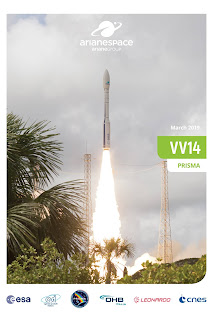NASA - EOS Terra Mission patch.
March 23, 2019
On Dec. 18, 2018, a large "fireball" - the term used for exceptionally bright meteors that are visible over a wide area - exploded about 16 miles (26 kilometers) above the Bering Sea. The explosion unleashed an estimated 173 kilotons of energy, or more than 10 times the energy of the atomic bomb blast over Hiroshima during World War II.
Animation above: This image sequence from the MISR instrument, aboard the Terra satellite, was taken a few minutes after a meteor exploded over the Bering Sea on Dec. 18. 2018. It shows the shadow of the meteor's trail, and the orange-tinted cloud it left behind. Animation Credits: NASA/GSFC/LaRC/JPL-Caltech, MISR Team.
Two NASA instruments aboard the Terra satellite captured images of the remnants of the large meteor. The image sequence shows views from five of nine cameras on the Multi-angle Imaging SpectroRadiometer (MISR) instrument taken at 23:55 Coordinated Universal Time (UTC), a few minutes after the event. The shadow of the meteor's trail through Earth's atmosphere, cast on the cloud tops and elongated by the low sun angle, is to the northwest. The orange-tinted cloud that the fireball left behind by super-heating the air it passed through can be seen below and to the right of the GIF's center.
The still image, captured by the Moderate Resolution Imaging SpectroRadiometer (MODIS) instrument, is a true-color image showing the remnants of the meteor's passage, seen as a dark shadow cast on thick, white clouds. MODIS captured the image at 23:50 UTC.
Image above: NASA's MODIS instrument, aboard the Terra satellite, captured this true-color image showing the remnants of a meteor's passage, seen as a dark shadow cast on thick, white clouds on Dec. 18, 2018. Image Credits: NASA GSFC.
The Dec. 18 fireball was the most powerful meteor to be observed since 2013; however, given its altitude and the remote area over which it occurred, the object posed no threat to anyone on the ground. Fireball events are actually fairly common and are recorded in the NASA Center for Near Earth Object Studies database.
Artist's concept of Terra satellite. Image Credits: NASA/JPL
The Terra spacecraft was launched in 1999 and is managed by NASA's Goddard Space Flight Center in Greenbelt, Maryland. The MISR instrument was built and is managed by NASA's Jet Propulsion Laboratory in Pasadena, California, for NASA's Science Mission Directorate in Washington. JPL is a division of Caltech. The MISR data were obtained from the NASA Langley Research Center Atmospheric Science Data Center in Hampton, Virginia. The MODIS instrument is managed by NASA's Goddard Space Flight Center.
Related article:
An meteor explosion like ten times Hiroshima goes unnoticed
https://orbiterchspacenews.blogspot.com/2019/03/an-meteor-explosion-like-ten-times.html
More information about EOS Terra and MISR and MODIS is available at the following site(s):
EOS Terra Satellite: https://terra.nasa.gov/
https://www-misr.jpl.nasa.gov/
https://terra.nasa.gov/about/terra-instruments/modis
NASA Center for Near Earth Object Studies database: https://cneos.jpl.nasa.gov/fireballs
Images (mentioned), Animation (mentioned), Text, Credits: NASA/JPL/Esprit Smith/GSFC/Patrick Lynch.
Greetings, Orbiter.ch
















































